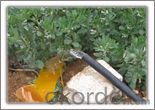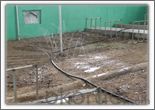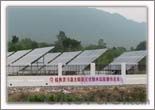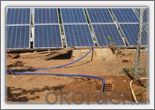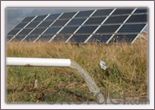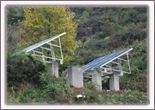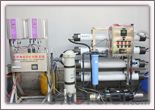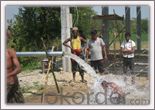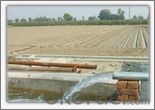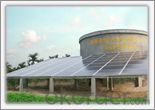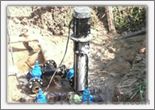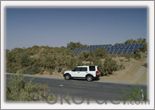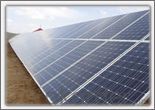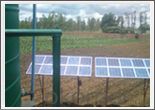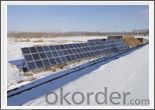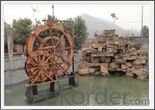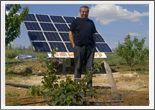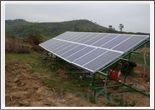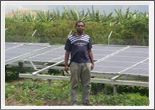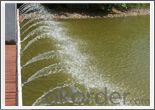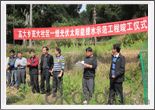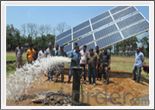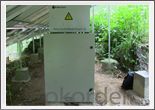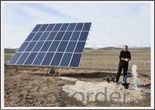DC Solar Water Pump Controller, Pumping System
- Loading Port:
- Shekou
- Payment Terms:
- TT OR LC
- Min Order Qty:
- 20 set
- Supply Capability:
- 100000 set/month
OKorder Service Pledge
OKorder Financial Service
You Might Also Like
Products
Solar Inverter Introduction:
Solar pumping inverter converts DC current from the solar array into AC current to drive the pump. With the function of MPPT (maximum power point tracking), it regulates the output frequency according to irradiation in real time to achieve the maximum power.
Solar Inverters Features:
1. Adopting the proposed dynamic VI maximum power point tracking (MPPT) control method; Fast response and stable operation; Better than the conventional methods which may lead to the problems including poor tracking performances, unstable or even cause water hammer damaging when the irradiation on the array changes rapidly.
2. The solar pumping inverters system is dispensed with energy storing devices, and stores water instead of electricity. It improves the reliability of the device, at the same time, it lowers the construction and maintenance costs of the system dramatically.
3. Digital control; automatic operation and data acquisition/storage of 8 years, etc; 98% of conversion efficiency, and complete protection.
4. In-line blocks; user friendly; convenient for operating; perfect cooling and shielding.
Technical Featrues
Solar Pumping Inverter Advantages:
1. To drive pumps equipped with 3-phase induction motors.
2. Optimized SPWM.
3. Various operation modes and MPPT algorithms are available.
4. Adjustable speed range of pump based on the actual situation of the system.
5. Available option of water-level detecting and control circuit.
6. Protection functions: lightning, over/low input voltage, over current and over load protection, etc.
7. Enclosure class: IP52.
8. Ambient temperature:-10~+50˚C.
Success Stories
►Middle East ►NaQu ►GuiLin
►Turkey ►XiNing ►YunNan
►Army stationed island ►Bangladesh ►Pakistan
►HaiNan ►HuBei ►Uganda
►XinJiang ►NingXia ►Afghan
►Zimbabwe ►Inner Mongolia ►Zhejiang
►Guangxi Guilin ►Turkey2 ►Botswana
►Naning ►Uganda ►Shaanxi
►Tsinghua University ►Pakistan ►Yunnan2
►FuJian ►Banqladesh ►YunNan3
►Turkey ►Inner Mongolia ►Senegal
Product Specifications
Model | Maximum input dc voltage | Recommended MPP Voltage | Rated Output Current | Output Voltage | Output Frequency | Net Weight | Gross Weight | Package Size | ||
Length | Width | Height | ||||||||
PB400L | 450 | 280-350 | 3 | 3PH 220V | 0-50 | 3.4 | 4.9 | 320 | 280 | 225 |
PB750L | 450 | 280-350 | 5 | 3PH 220V | 0-50 | 3.4 | 4.9 | 320 | 280 | 225 |
PF750L | 450 | 150-350 | 5 | 3PH 220V | 0-60 | 6.1 | 7.1 | 425 | 325 | 250 |
PB1500L | 450 | 280-350 | 7 | 3PH 220V | 0-50 | 4.0 | 5.6 | 355 | 280 | 225 |
PF1500L | 450 | 150-350 | 7 | 3PH 220V | 0-60 | 7.5 | 8.5 | 425 | 325 | 285 |
PB2200L | 450 | 280-350 | 11 | 3PH 220V | 0-50 | 4.0 | 5.6 | 355 | 280 | 225 |
PF2200L | 450 | 150-350 | 11 | 3PH 220V | 0-60 | 7.9 | 9.0 | 425 | 325 | 285 |
PB3700LA | 450 | 280-350 | 17 | 3PH 220V | 0-50 | 7.2 | 9.5 | 425 | 325 | 285 |
PB5500LA | 450 | 280-350 | 25 | 3PH 220V | 0-50 | 7.3 | 9.6 | 425 | 325 | 285 |
PB3700H | 750 | 500-600 | 9 | 3PH 380V | 0-50 | 7.2 | 9.5 | 425 | 325 | 285 |
PB5500H | 750 | 500-600 | 13 | 3PH 380V | 0-50 | 7.3 | 9.6 | 425 | 325 | 285 |
PB7500H | 750 | 500-600 | 18 | 3PH 380V | 0-50 | 7.7 | 10 | 425 | 325 | 285 |
PB11KH | 750 | 500-600 | 24 | 3PH 380V | 0-50 | 8.2 | 10.5 | 425 | 325 | 285 |
PB15KH | 750 | 500-600 | 30 | 3PH 380V | 0-50 | 8.4 | 10.7 | 425 | 325 | 285 |
PB18KH | 750 | 500-600 | 39 | 3PH 380V | 0-50 | 8.4 | 10.7 | 425 | 325 | 285 |
PB22KH | 750 | 500-600 | 45 | 3PH 380V | 0-50 | 18 | 21 | 600 | 465 | 350 |
PB30KH | 750 | 500-600 | 60 | 3PH 380V | 0-50 | 18 | 21 | 600 | 465 | 350 |
PB37KH | 750 | 500-600 | 75 | 3PH 380V | 0-50 | 20 | 23 | 600 | 465 | 350 |
PB45KH | 750 | 500-600 | 91 | 3PH 380V | 0-50 | 20 | 23 | 600 | 465 | 350 |
PB55KH | 750 | 500-600 | 112 | 3PH 380V | 0-50 | 20 | 23 | 600 | 465 | 350 |
- Q:Can a solar controller be used with solar panel tracking systems?
- Yes, a solar controller can be used with solar panel tracking systems. The solar controller is responsible for regulating the charging and discharging of the battery in a solar system. It ensures that the battery is charged efficiently and prevents overcharging or over-discharging. When used with solar panel tracking systems, the solar controller will continue to monitor and regulate the battery charging process, irrespective of the movement of the solar panels.
- Q:How does a solar controller handle battery under-voltage protection?
- A solar controller handles battery under-voltage protection by monitoring the voltage of the battery connected to the solar system. If the battery voltage drops below a preset threshold, the solar controller will automatically disconnect the battery from the charging source, preventing further discharge and potential damage to the battery. This feature ensures the longevity and health of the battery while optimizing its performance.
- Q:How does a solar controller handle the protection against battery reverse polarity?
- A solar controller handles the protection against battery reverse polarity by implementing a built-in mechanism that prevents the flow of current in the wrong direction. This is typically achieved through the use of diodes or MOSFETs that act as one-way valves, allowing only the correct flow of current from the solar panels to the battery. As a result, it safeguards the battery from potential damage caused by reverse polarity.
- Q:What is the maximum voltage input for a solar controller?
- The maximum voltage input for a solar controller varies depending on the specific model and manufacturer. However, in general, a typical solar controller can handle voltages ranging from 12V to 48V. It is important to check the specifications provided by the manufacturer to ensure the solar controller is compatible with the specific voltage of the solar panels being used.
- Q:Can a solar controller be used with solar-powered data centers?
- Yes, a solar controller can be used with solar-powered data centers. A solar controller is a crucial component of a solar power system that regulates the flow of electricity generated by solar panels. It ensures that the solar power system operates efficiently and effectively by managing the charging and discharging of batteries. In a solar-powered data center, a solar controller helps optimize the utilization of solar energy, enabling the data center to rely on renewable energy sources and reduce its carbon footprint.
- Q:Can a solar controller be used with a solar-powered biomass plant?
- No, a solar controller cannot be used with a solar-powered biomass plant. A solar controller is designed specifically for regulating and optimizing the performance of solar panels and batteries. It is not compatible with the unique requirements and systems of a solar-powered biomass plant, which involves the conversion of organic matter into energy through combustion or other processes. Different control systems and mechanisms are needed to effectively manage and control the biomass plant's operations.
- Q:What is the maximum charging current that a solar controller can provide to batteries?
- The maximum charging current that a solar controller can provide to batteries depends on the specific controller's specifications and capabilities. It can range from a few amps to several tens of amps, depending on factors such as the controller's design, size, and intended application.
- Q:How do I connect multiple solar controllers together?
- To connect multiple solar controllers together, you will need to follow a few steps: 1. Identify the type of solar controllers you have: Before connecting them together, it's crucial to ensure that the solar controllers are compatible with each other. Check the specifications and features of each controller to verify if they can be connected in parallel or series. 2. Determine the connection method: There are two common methods for connecting multiple solar controllers - parallel and series. Parallel connection involves connecting the positive terminals of all controllers together and the negative terminals together. Series connection, on the other hand, requires connecting the positive terminal of one controller to the negative terminal of the next controller. 3. Connect the solar controllers: Once you have determined the appropriate connection method, you can start connecting the controllers. Ensure that all connections are secure and tight to avoid any loose connections or electrical faults. Use appropriate wiring and connectors depending on the size and type of the controllers. 4. Configure the controllers: After connecting the controllers physically, you may need to configure some settings for them to work together efficiently. Consult the user manuals or documentation provided with the controllers to understand how to configure them correctly. This may involve adjusting charging parameters, setting priority modes, or synchronizing the controllers. 5. Monitor and test: Once the controllers are connected and configured, it's essential to monitor their performance and test their functionality. Keep an eye on the charging and discharging patterns, battery voltage, and any error messages or alarms. Regularly check the system to ensure that all controllers are functioning correctly and charging the batteries effectively. Remember, it's important to consult a professional or refer to the manufacturer's guidance if you are unsure about any aspect of connecting solar controllers together. Safety should always be a priority when dealing with electrical connections, especially when it comes to solar power systems.
- Q:Can a solar controller be used with solar-powered indoor cultural facilities?
- Solar-powered indoor cultural facilities can indeed utilize a solar controller. The purpose of a solar controller is to regulate the charging and discharging of batteries within a solar power system. Traditionally, solar power has been associated with outdoor applications such as residential or commercial buildings. However, it can also be effectively employed in indoor cultural facilities such as museums, art galleries, libraries, or exhibition halls that prioritize sustainability and environmental friendliness. Implementing a solar controller in these facilities offers several advantages. Firstly, it ensures that the solar panels efficiently convert sunlight into electricity and effectively charge the batteries. By controlling the energy flow, it prevents overcharging, which can potentially harm the batteries. As a result, a reliable and consistent power supply is guaranteed for the indoor cultural facility. Furthermore, a solar controller aids in monitoring the energy consumption of the facility. It provides real-time data on solar power generation, battery status, and overall energy usage. This valuable information enables facility managers to optimize energy consumption, identify any potential issues, and make well-informed decisions to enhance energy efficiency. Moreover, solar controllers often come equipped with built-in features like load control and timers. This allows facility managers to exercise control over the utilization of solar power within the indoor cultural facility. For instance, lights or climate control systems can be programmed to operate during specific hours or only when necessary. This approach minimizes energy wastage and maximizes the utilization of solar power. In conclusion, there is no doubt that a solar controller can be effectively employed in solar-powered indoor cultural facilities. It facilitates efficient energy conversion, enables energy consumption monitoring, and empowers control over solar power usage. By embracing the use of a solar controller, indoor cultural facilities can become more sustainable, reduce their environmental impact, and simultaneously maintain a reliable power supply.
- Q:Can a solar controller be used with a solar electric vehicle charging station?
- Yes, a solar controller can be used with a solar electric vehicle charging station. A solar controller is responsible for regulating the flow of electricity from the solar panels to the battery or charging station. By using a solar controller, the charging station can effectively manage and optimize the power generated from the solar panels, ensuring efficient charging of electric vehicles.
1. Manufacturer Overview |
|
|---|---|
| Location | |
| Year Established | |
| Annual Output Value | |
| Main Markets | |
| Company Certifications | |
2. Manufacturer Certificates |
|
|---|---|
| a) Certification Name | |
| Range | |
| Reference | |
| Validity Period | |
3. Manufacturer Capability |
|
|---|---|
| a)Trade Capacity | |
| Nearest Port | |
| Export Percentage | |
| No.of Employees in Trade Department | |
| Language Spoken: | |
| b)Factory Information | |
| Factory Size: | |
| No. of Production Lines | |
| Contract Manufacturing | |
| Product Price Range | |
Send your message to us
DC Solar Water Pump Controller, Pumping System
- Loading Port:
- Shekou
- Payment Terms:
- TT OR LC
- Min Order Qty:
- 20 set
- Supply Capability:
- 100000 set/month
OKorder Service Pledge
OKorder Financial Service
Similar products
New products
Hot products
Hot Searches
Related keywords













